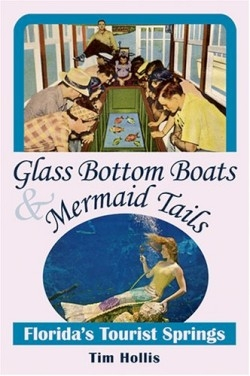It looks like you've stumbled upon a page meant to be read by our code instead of viewed directly. You're probably looking for this page.
Glass Bottom Boats and Mermaid Tails
Florida's Tourist Springs
Long before 1971 when the Magic Kingdom became Disney World’s first theme park, Florida was well established as a tourist destination. Among the state’s many attractions, natural springs ranked high. The author, an expert on the South’s roadside history, devotes his third book on Southern tourism to the intriguing story of Florida’s springs, how visitors were drawn to them, and what eventually happened when Disney World overshadowed them by making Orlando a world-class vacation spot.
Each of Florida’s five major springs gets a chapter in Hollis’s well-illustrated book. He begins with Silver Springs, which for many years was what Hollis calls “the monarch of the state’s many attractions. The great-great-grandpappy of them all.” It is the largest limestone artesian spring formation in the world, with an average output of 550 million gallons a day, although this is not mentioned in the book. The early Native peoples considered springs sacred and paid homage to them in elaborate ceremonies. Hollis traces the development of Silver Springs as a tourist attraction, beginning in the post-Civil War years when access was only by steamboat. He discusses the property owners and the invention of the glass bottom boat to view the natural beauty of the springs, and describes added attractions at Silver Springs and its neighborhood, as well as use of the area for movies and television shows. Samples of the advertising brochures featuring pretty girls are presented. Although Silver Springs has long passed its heyday, Hollis takes comfort from the fact that it continues to exist with its glass bottom boats.
The other four springs are described—Wakulla Springs, Rainbow Springs, Weeki Wachee Spring, and Homosassa Springs—with displays of publicity photos featuring bathing beauties. Weeki Wachee sold itself as the “Spring of the Mermaids,” and developed an underwater swimming show with a cumbersome fish tail attached to the female swimmers. When ABC-Paramount bought Weeki Wachee, “the performances blossomed into lavish productions more akin to Broadway shows.” However, the construction of a new inter-state highway cut the traffic on the road where Weeki Wachee was located and it barely manages to survive.
Ups and downs in the tourist industry and fierce competition among the attractions have taken their toll. Three of what Hollis calls the “big five” of Florida’s springs have found the formula for continued existence by becoming state parks, and he sets forth in detail the paths they took to remaining alive. A final chapter discusses a few of the other springs, their development, and their demise. The book concludes with Hollis’s tribute to those who turned natural springs into tourist destinations. His enthusiasm for these entrepreneurs, their ingenuity, and their hucksterism is expressed in his final sentence: “They certainly created ripples in their springs that extended far beyond the confinements of their banks.”
Reviewed by
Morton I. Teicher
Disclosure: This article is not an endorsement, but a review. The publisher of this book provided free copies of the book to have their book reviewed by a professional reviewer. No fee was paid by the publisher for this review. Foreword Reviews only recommends books that we love. Foreword Magazine, Inc. is disclosing this in accordance with the Federal Trade Commission’s 16 CFR, Part 255.
